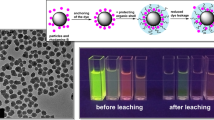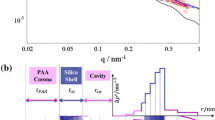Abstract
Using hollow silica nanoparticles we demonstrate a simple and highly efficient way of removing hydrophilic dye (Rhodamine B) from water by encapsulation within these hollow spheres. The hollow silica spheres were obtained by using a surfactant templated procedure. Using fluorescence spectroscopy, we also show the evidence of the dye being absorbed within the hollow core of the silica shell (which is crucial for many applications) and differentiate from the adsorption of dye on the surface of the silica shell. It was found that that up to 94 % of the hydrophilic dye could be entrapped using these hollow shells within 72 h of exposure. Fluorescence spectroscopy shows a red shift in the dye encapsulated in the hollow silica which is due to aggregation of the dye and enables us to follow quantitatively the uptake of the dye molecules by the silica shells with time. The evidence for the encapsulation of the dye in these hollow spheres was reinforced by carrying out a comparative study, using solid silica particles.

Evidence of encapsulation of dye in hollow silica by fluorescence spectroscopy





Similar content being viewed by others
References
Helmer R, Hespanhol I (1997) Water pollution control—a guide to the use of water quality management principles. E & FN Spon, London
Hildebrand H, Mackenzie K, Kopinke FD (2008) Novel nano-catalysts for wastewater treatment. Global NEST J 10:47–53
Jin X, Yu C, Li Y, Qi Y, Yang L, Zhao G, Hu H (2011) Preparation of novel nano-adsorbent based on organic–inorganic hybrid and their adsorption for heavy metals and organic pollutants presented in water environment. J Hazard Mater 186:1672–1680
Li YH, Zhao YM, Hu WB, Ahmad I, Zhu YQ, Peng XJ, Luan ZK (2007) Carbon nanotubes—the promising adsorbent in wastewater treatment. J Phys Conf Ser 61:698–702
Tiwari DK, Behari J, Sen P (2008) Application of nanoparticles in waste water treatment. World App Sci J 3:417–433
Yao Y, Yang Z, Zhang D, Peng W, Sun H, Wang S (2012) Magnetic CoFe2O4–graphene hybrids: facile synthesis, characterization and catalytic properties. Ind Eng Chem Res 51:6044–6051
Zhang Z, Kong J (2011) Novel magnetic Fe3O4@C nanoparticles as adsorbents for removal of organic dyes from aqueous solution. J Hazard Mater 193:325–329
Banerjee S, Dastidar MG (2005) Use of jute processing wastes for treatment of wastewater contaminated with dye and other organics. Bioresour Technol 96:1919–1928
Ali I, Mohammad A, Khan TA (2012) Low cost adsorbents for the removal of organic pollutants from wastewater. J Environ Manage 113:170–183
Yi DK, Selvan ST, Lee SS, Papaefthymiou GC, Kundaliya D, Ying JY (2005) Silica-coated nanocomposites of magnetic nanoparticles and quantum dots. J Am Chem Soc 127:4990–4991
Li H, Liu J, Xie S, Qiao M, Dai W, Lu Y, Li H (2008) Vesicle-assisted assembly of mesoporous Ce-doped Pd nanospheres with a hollow chamber and enhanced catalytic efficiency. Adv Funct Mater 18:3235–3241
Li LL, Tang FQ, Liu HY, Liu TL, Hao NJ, Chen D, Teng X, He JQ (2010) In vivo delivery of silica nanorattle encapsulated docetaxel for liver cancer therapy with low toxicity and high efficacy. ACS Nano 4:6874–6882
Zhu YF, Shi JL, Shen WH, Dong XP, Feng JW, Ruan ML, Li YS (2005) Stimuli-responsive controlled drug release from a hollow mesoporous silica sphere/polyelectrolyte multilayer core–shell structure. Angew Chem Int Ed 44:5083–5087
Zhang X, Clime L, Normandin F, Roberge HF, Yahia LH, Sacher E, Veres T (2011) pH-triggered doxorubicin delivery based on hollow nanoporous silica nanoparticles with free-standing superparamagnetic Fe3O4 cores. J Phys Chem C 115:1436–1443
Shi L, Lin H (2010) Facile fabrication and optical property of hollow SnO2 spheres and their application in water treatment. Langmuir 26:18718–18722
Yang J, Lee J, Kang J, Lee K, Suh JN, Yoon HG, Huh YM, Haam S (2008) Hollow silica nanocontainers as drug delivery vehicles. Langmuir 24:3417–3421
Kim YJ, Chai SY, Lee W (2007) Control of TiO2 structures from robust hollow microspheres to highly dispersible nanoparticles in a tetrabutylammonium hydroxide solution. Langmuir 23:9567–9571
Khin MM, Nair AS, Babu VJ, Murugan R, Ramakrishna S (2012) A review on nanomaterials for environmental remediation. Energy Environ Sci 5:8075–8109
Xia ZM, Chen JF, Li JF, Song JR, Wen LX (2009) Development of egg-shell nano catalysts with porous hollow silica supports for hydrogenation. J Nanosci Nanotechnol 9:1433–1436
Rahman MA, Shin J, Choi H, Yeo KM, Kang E, Lee I (2010) Hollow silica nanosphere having functionalized interior surface with thin manganese oxide layer: nanoreactor framework for size-selective Lewis acid catalysis. J Mater Chem 20:10615–10621
Han J, Fang P, Dai J, Guo R (2012) One-pot surfactantless route to polyaniline hollow nanospheres with incontinuous multicavities and application for the removal of lead ions from water. Langmuir 28:6468–6475
Vaidya S, Thaplyal P, Ganguli AK (2011) Uptake of hydrophilic toxins in hollow silica shells obtained from core-shell nanostructures. Proc Indian Natn Sci Acad 77:99–103
Botterhuis NE, Sun Q, Magusin PCMM, Santen RAV, Sommerdijk NAJM (2006) Hollow silica spheres with an ordered pore structure and their application in controlled release studies. Chem Eur J 12:1448–1456
Behnke T, Wurth C, Hoffmann K, Hunber M, Panne U, Resch-Genger U (2011) Encapsulation of hydrophobic dyes in polystyrene micro and nanoparticles via swelling procedures. J Fluoresc 21:937–944
Makarova OV, Ostafin AE, Miyoshi H, Norris JR (1999) Adsorption and encapsulation of fluorescent probes in nanoparticles. J Phys Chem B 103:9080–9084
Park JH, Kim KY, Park JM (2010) Polymer hollow particles: Encapsulation of phosphoric acid partial esters and morphology manipulation. Polymer 51:3014–3022
Gröger H, Kind C, Leidinger P, Roming M, Feldmann C (2010) Nanoscale hollow spheres: microemulsion-based synthesis, structural characterization and container-type functionality. Materials 3:4355–4386
Wang X, Danoff EJ, Sinkov NA, Lee JH, Raghvan SR, English DS (2006) Highly efficient capture and long-term encapsulation of dye by cationic surfactant vesicles. Langmuir 22:6461–6464
Han L, Gao C, Wu X, Chen Q, Shu P, Ding Z, Che S (2011) Anionic surfactants templating route for synthesizing silica hollow spheres with different shell porosity. Solid State Sci 13:721–728
de Boer JH (1958) The structure and properties of porous materials. Butterworth, London
Zhu Y, Shi J, Shen W, Dong X, Feng J, Ruan M, Li Y (2005) Stimuli-responsive controlled drug release from a hollow mesoporous silica sphere/polyelectrolyte multilayer core–shell structure. Angew Chem 117:5213–5217
Pablo M, Arnal D, Comotti M, Schüth F (2006) High-temperature-stable catalysts by hollow sphere encapsulation. Angew Chem 118:8404–8407
Gabudean AM, Lerouge F, Gallavardin T, Iosin M, Zaiba S, Maury O, Baldeck PL, Andraud C, Parola S (2011) Synthesis and optical properties of dyes encapsulated in gold hollow nanoshells. Opt Mater 33:1377–1381
Chavez JL, Wong JL, Jovanovic AV, Sinner EK, Duran RS (2005) Encapsulation in sub-micron species: a short review and alternate strategy for dye encapsulation. IEE Proc Nanobiotechnol 152:64–72
El-Rayyes A, Al-Betar A, Htun T, Klein UKA (2005) Fluorescence emission from Rhodamine-B lactone adsorbed at solid catalysts. Chem Phys Lett 414:287–291
Hussain SA, Banik S, Chakraborty S, Bhattacharjee D (2011) Adsorption kinetics of a fluorescent dye in a long chain fatty acid matrix. Spectrochim Acta A 79:1642–1647
Acknowledgment
A.K.G. thanks the Department of Science & Technology, Govt. of India, and DEITY, Govt. of India, for financial support. A.B.. thanks UGC for a fellowship.
Author information
Authors and Affiliations
Corresponding author
Electronic supplementary material
Below is the link to the electronic supplementary material.
Figure S1
PXRD pattern of hollow silica particles. (DOCX 64 kb)
Rights and permissions
About this article
Cite this article
Baruah, A., Kumar, S., Vaidya, S. et al. Efficient Entrapment of Dye in Hollow Silica Nanoparticles: Direct Evidence Using Fluorescence Spectroscopy. J Fluoresc 23, 1287–1292 (2013). https://doi.org/10.1007/s10895-013-1262-2
Received:
Accepted:
Published:
Issue Date:
DOI: https://doi.org/10.1007/s10895-013-1262-2




